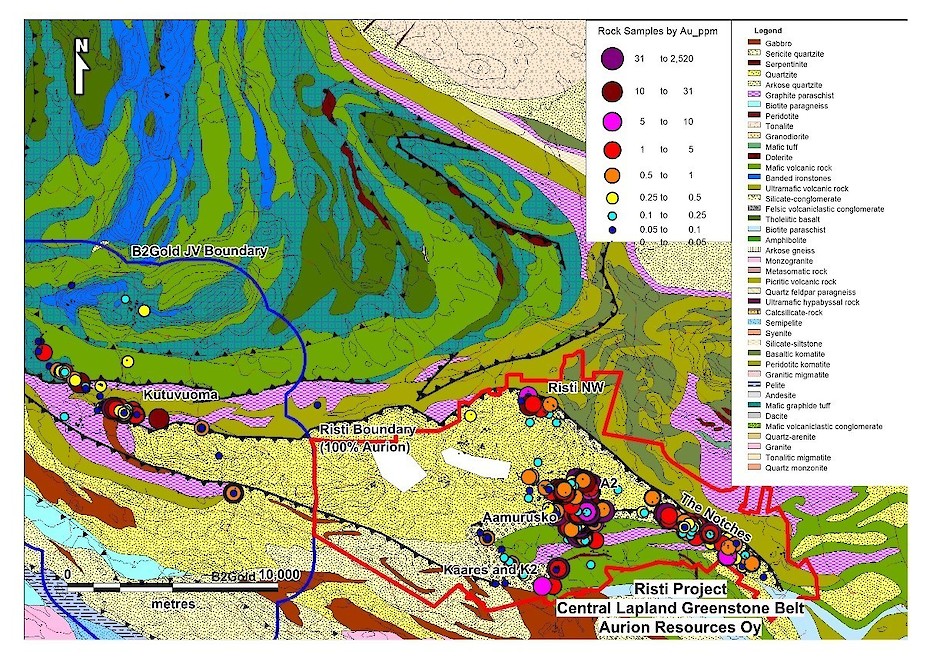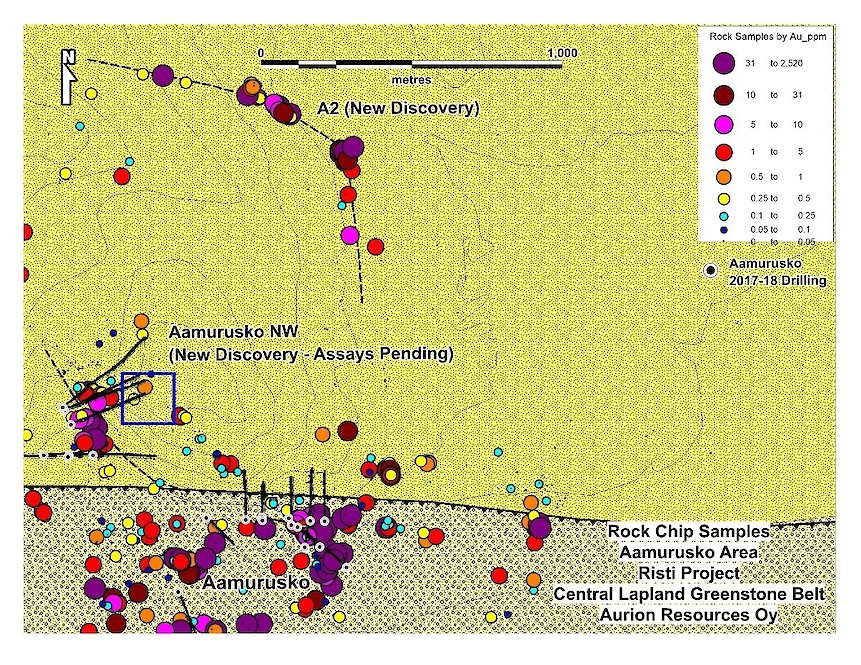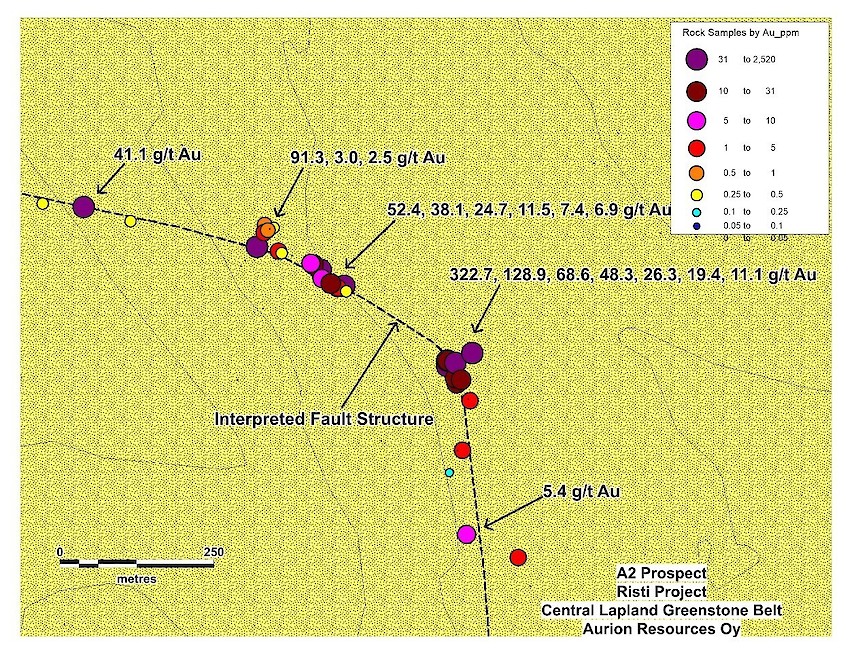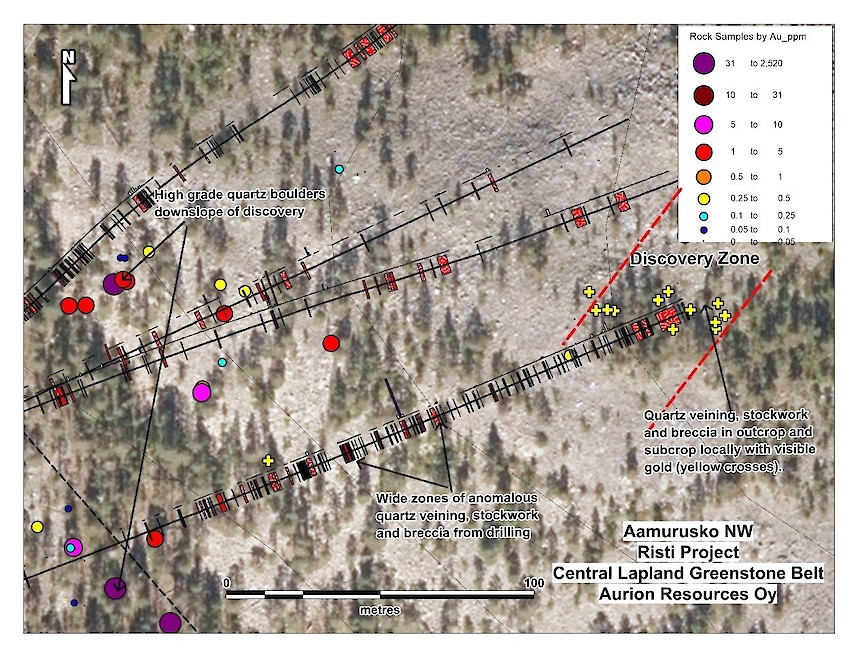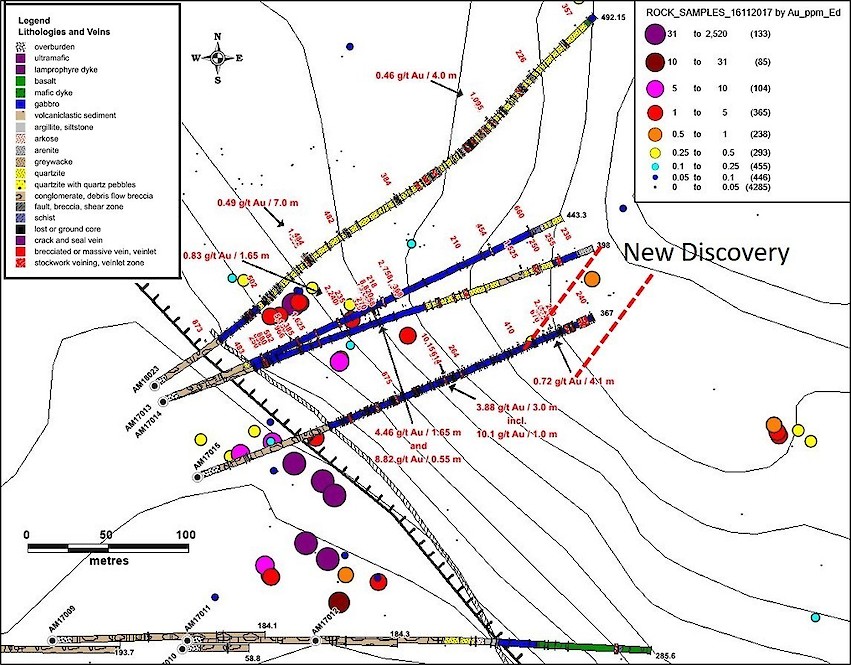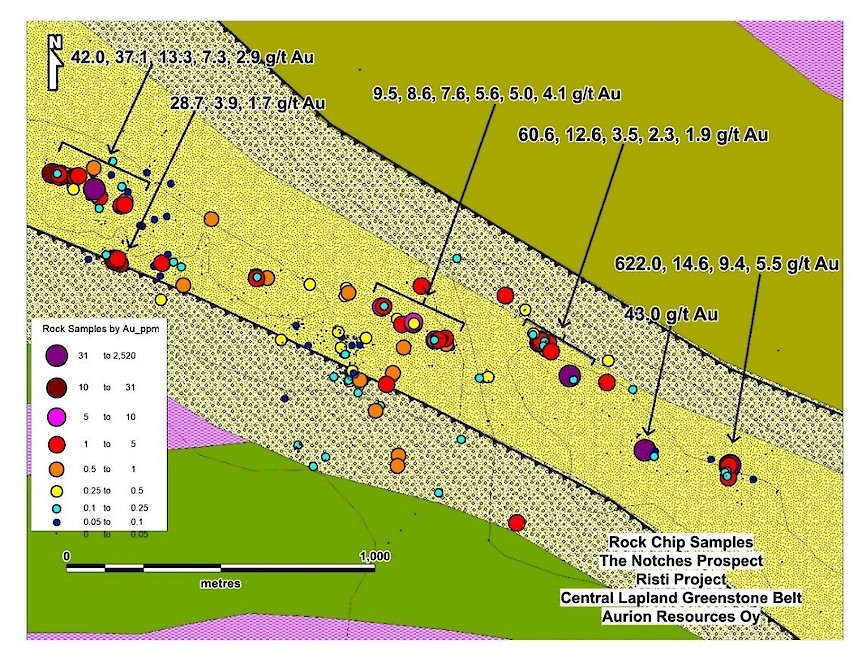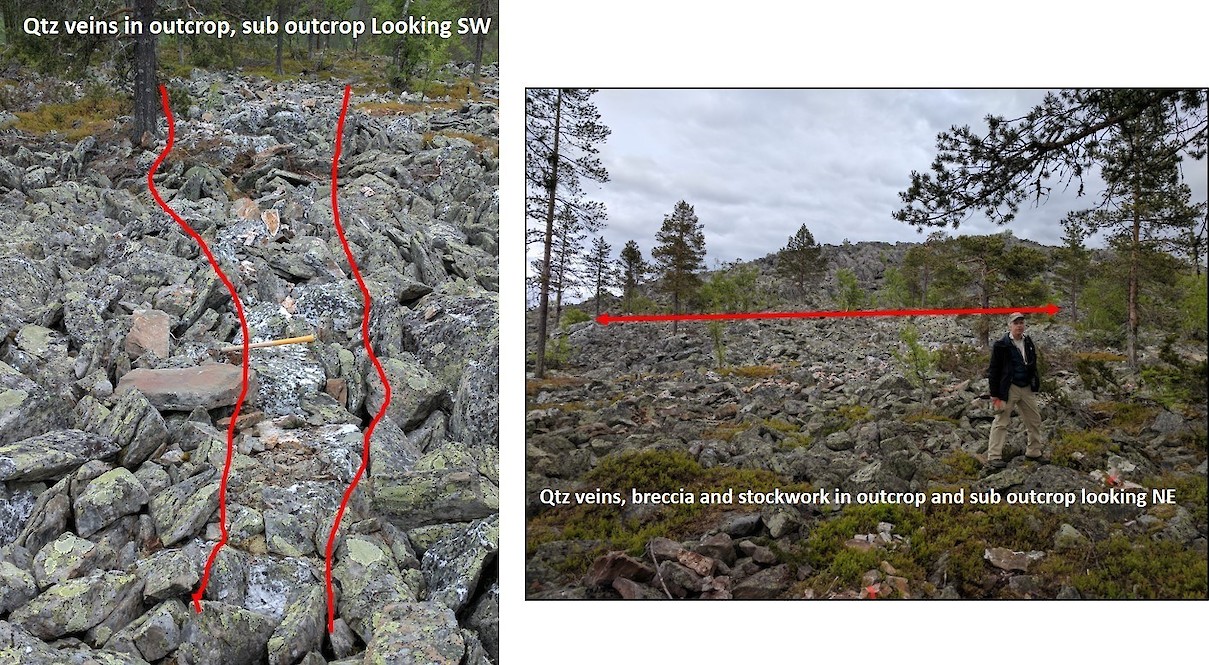Aurion Commences 2018 Field Exploration Program and Reports Two New High Grade Gold Discoveries
Aurion Resources Ltd. (TSXV: AU) (“Aurion” or the “Company”) is pleased to report that field exploration programs are underway on Aurion’s project areas in the Central Lapland Greenstone Belt (CLGB) of Northern Finland. The primary focus is to locate the source or sources of the extensive high-grade surface mineralization discovered during the 2016/17 field seasons at the Aamurusko prospect within the 15,000 hectare Risti Project. The 2018 budget is approximately CAN$8-million, which will include quaternary glacial geomorphology studies, trenching, prospecting, detailed structural geological mapping, geochemical sampling, drone geophysics, drone aerial photography and a 15,000 metre (m) diamond drilling program.
New Discoveries
Two significant new high grade gold prospects located North and Northwest of the Aamurusko boulder fields have recently been discovered, identifying one potential source of the high grade boulders at Aamurusko and expanding the company’s understanding of the structural controls within the system.
The A2 Prospect is located approximately 850 m to 1,500 m to the north of the Aamurusko boulder field. A total of 53 rock chip samples in outcrop, subcrop and angular boulders from reconnaissance prospecting, assaying between nil and 322.7 g/t Au and averaging 18.6 g/t Au were collected over a distance of 1.1 km along an arcuate structure. Mineralization consists of quartz veins (locally up to 3 m wide), quartz stockworks, breccias and sediment hosted disseminated mineralization. Additional assays are pending. See Figures 1, 2 and 3.
It is believed that this mineralized structure is not a source of the high grade boulders at Aamurusko. Phase 2 drilling will test this target.
The Aamurusko NW Prospect is located approximately 400 m North-Northwest of the main Aamurusko boulder field. It comprises a 20-30 mwide zone of NE-SW trending quartz veins, breccias and stockworks in outcrop and subcrop. The mineralization recently discovered through prospecting is exposed over a 50 m strike length before it is concealed under cover. Individual veins are up to 1.5 m wide and over 14 rock chip samples contain visible gold. This new discovery is believed to represent at least one source of the high grade boulders within Aamurusko. Assays are pending. See Figures 2 and 4.
This area is also located approximately 250 m ENE of drillholes AA0017-13 to 15 and 23 which intersected wide zones of anomalous extensional quartz veining. The trend of the new discovery veins is subparallel to the azimuth of these drillholes. The orientation of the new vein zone also suggests that prior drilling azimuths were not optimal. See Figure 5. Phase 2 drilling will test this target.
2018 Program Details
Aurion has undertaken a quaternary glacial geomorphology study aimed at determining the influence of glacial activity, ice direction and dispersion within the Risti area. The main objective is to specifically determine the distance of glacial dispersion to ultimately identify the source of the 1,217 large and angular quartz blocks. Preliminary results of the study have determined the principal direction of transport and indicated the potential sources of the quartz blocks. Possible source areas are now the subject of a detailed campaign of prospecting, mapping and sampling.
Structural and lithological mapping is being conducted in conjunction with a detailed drone magnetic survey and together with drillcore data produced during the winter program will be compiled into a 3D geological model.
Drilling at Aamurusko and other target areas is expected to begin in early July, 2018 and continue until February 2019. Initial plans include completing 15,000 m.
Risti/Aamurusko
The Aamurusko zone is an open-ended 1,700-m-long-by-2,400 m-wide zone comprised of many large and angular, quartz-tourmaline blocks within the 15,000 hectare Risti property (See attached Figure 1). Sampling during 2016 and 2017 included the collection of 1,217 rock grab samples assaying from nil to 2,520 grams per tonne gold, including 122 samples that assayed greater than 31 grams per tonne gold (g/t Au). The average grade of all 1,217 samples is 24.7 g/t Au. Many of these samples contain abundant coarse visible gold. Numerous quartz blocks within this trend are over 1.0 metre (m) in at least one dimension and locally reach up to 3.5 m by 3.0 mby one m in size (see Aurion’s press release dated Feb. 1, 2017). Channel sampling from a selection of these boulders assayed up to 43.3 g/t Au over 1.65 m and 20.6 g/t Au over 2.5 m (see Aurion’s press release dated Sept. 14, 2017). Property-wide, 2557 rock samples were collected during 2016-2017 field seasons assaying an average grade of 10.1 g/t Au (see Figure 1).
A maiden Phase 1 drill program of 5500 m in 23, 50-100 m spaced drillholes was conducted during Q4-17 and Q1-18. Wide intersections (locally >20 m) of anomalous quartz veining were intersected in 10 holes, outlining two mineralized zones. Both zones are open and are interpreted to be along a common structure separated by a distance of approximately 600 m which has yet to be drill tested. Individual veins assayed up to 11.2 g/t Au over 0.5 m and 10.1 g/t Au over 1.0 m. (See press release dated Jan 17, 2018). A new structural interpretation as well as the new discovery at Aamurusko NW suggests drilling in a different orientation than was conducted during Phase 1.
The Risti property contains several additional target areas, including The Notches, K2 and Kaareselka (see Aurion’s press release dated Sept. 14, 2017).
The Notches represents an approximately 1 km wide by 5 km long NW-SE ridge of Kumpu quartzite and conglomerate hosting numerous high grade quartz-carbonate pyrite veins, stockworks and breccias. See attached Figures 1 and 6. Extensive trenching is underway on these targets. Phase 2 drilling will also test these targets.
The K2 Prospect represents a quartz vein boulder field located 1.8 km SW of Aamurusko which assayed from nil to 166.0 g/t Au (See press release dated Sept 14, 2017).
Kaareselka (Kaares) is a high grade shear hosted gold vein system located approximately 4 km SW of Aamurusko. It was discovered by the Geological Survey of Finland (GTK) in the late 1980’s. Aurion acquired the prospect from Tertiary Minerals Plc.. GTK drilled approximately 170 drillholes on several targets within an area of 1 km by 1 km. Select historical intercepts of 13.5 g/t Au over 2.75 m, 11.02 g/t Au over 4.9 m, 45.3 g/t Au over 1.4 m and 16.2 g/t Au over 1.5 m were reported by GTK and Tertiary. Aurion is compiling all historic data with a view to developing new targets within this prospect.
Background
The geological setting of the Risti project has many similarities to prolific gold-rich orogenic gold belts globally, specifically the Timmins camp of the Abitibi province of Northern Ontario. The Aamurusko zone appears to be underlain by young unconformable clastic rocks (meta-sandstones and conglomerates) of the Kumpu group. These Kumpu group conglomerates resemble the Timiskaming conglomerates of the Timmins and Kirkland Lake area of the Abitibi province and occur in a similar geo-tectonic setting (both represent the youngest stratigraphic sequence within their respective belts). The Kumpu group and the Timiskaming group were deposited in late orogenic extensional basins. They form in relation to major movement along regional faults or deformation zones. In the Abitibi province, many high-grade, multimillion-ounce gold deposits are temporally and spatially associated with the Timiskaming conglomerates (or their equivalents) in close proximity to major regional deformation (fault) zones such as the Porcupine-Destor or Cadillac Lake-Larder Lake deformation zones. The Kumpu group appears to have been deposited in a similar geological setting adjacent to the Sirkka shear zone, which is a major deformation zone in the CLGB. Strong alteration including fuchsite, tourmaline, iron carbonate, albite and quartz veining is seen along the entire length of this structure. Regional prospecting and reconnaissance mapping targeting mineralization in this setting are also under way.
Partner Activity
Kinross
Kinross has advised Aurion it has a planned 2018 exploration budget on the Outa joint venture of US$0.8 million.
Outa is primarily underlain by clastic sediments of the Kumpu group deposited in a setting similar to Risti. Limited historical exploration work by the Geological Survey of Finland (GTK) documented possible paleo-placer-style gold mineralization at the south end of the project. Shallow drilling by GTK intersected 121 grams per tonne gold over 1.5 m. Most of the greater-than-15-km-long unconformity between Kumpu group clastics and Kittila group mafic volcanics within the Outa project area has never been explored. Kinross is conducting detailed Drone magnetic geophysical and orthophoto surveys, ground gravity geophysical surveys, prospecting and mapping.
Subject to a non-binding Letter of Intent Kinross can earn 70% of Outa by completing USD $5.0 million of exploration expenditures. A definitive option and joint venture agreement is being finalized.
B2Gold
B2Gold has advised Aurion it has a planned 2018 US$2.6 million exploration budget on the Kutuvuoma joint venture.
The Kutuvuoma deposit is a high-grade, shear zone hosted gold deposit that was discovered in the mid-1990’s by Outokumpu Oy, a publicly listed company in which the Finnish state is a controlling shareholder. Outokumpu drilled 47 shallow core and reverse circulation drillholes totalling 3,425 m, testing Kutuvuoma within a very small area (approximately 175 m horizontally and 175 m vertically). No other drilling or trenching was conducted since the mid-1990’s. Numerous high-grade drill intercepts including 7.2 g/t Au over 19.4 m from 60 m downhole, 13.2 g/t Au over 5.0 m from 88 m downhole and 12.6 g/t Au over 7.0 m from 26 mdownhole were recorded from the historical drilling. True width of the mineralization is estimated to be approximately 70-80% of drill intercepts. B2Gold plans extensive BoT sampling, prospecting, mapping, trenching and possible drilling pending target identification.
B2gold can earn a 70-per-cent interest in an approximately 25,000-hectare property area by spending $15-million over six years and issuing Aurion 550,000 B2Gold shares. It can earn an additional 5 % by completing a positive feasibility study for a total of 75 %.
Quality Assurance and Quality Control
All samples were delivered to ALS Minerals preparation facility in Sodankyla, Finland where sample preparation work was completed. All analytical work was completed at ALS Minerals facility in Loughrea, Ireland. ALS Minerals is an internationally accredited lab and are ISO compliant (ISO 9001:2008, ISO/IEC 17025:2005). All samples were analyzed for gold using the Au-AA24 procedure (50g fire assay with AAS finish: Detection Limit 0.005 g/t gold; Upper Limit – 10g/t gold). Any samples that returned overlimit values (>10.0g/t gold) were automatically analyzed by gravimetric analysis, Au-GRA22 (50g gravimetric analysis: Detection Limit 0.05g/t gold: Upper Limit 1,000g/t gold). Any samples containing visible gold were analyzed by Au-SCR24 1kg, Screen Fire Assay Au (0.05-1,000ppm) by 1kg screen fire assay (50g nominal sample weight). The sample pulp (1kg) is passed through a 150 micron stainless steel screen. Any material remaining on the screen (>150 micron) is retained and analyzed in its entirety by fire assay with gravimetric finish and reported as the Au (+) fraction. The material passing through the screen (<150 micron) is homogenized and two sub-samples are analyzed by fire assay with AAS finish. The average of the two AAS results is taken and reported as the Au (-) fraction result. All three values are used in calculating the combined gold content of the plus and minus fractions. The gold values for both the (+) 150 and (-) 150 micron fractions are reported together with the weight of each fraction as well as the calculated total gold content of the sample.) Multi-element analysis (ME-ICP61, four-acid digestion, 35 element ICP-AES) was completed on all samples. Certified standards and blanks were inserted every 25 samples. ALS has its own QA/QC protocol using standards, blanks and duplicates.
Mike Basha, P.Eng., P.Geo., President and CEO of Aurion, a Qualified Person as defined by National Instrument 43-101, is responsible for the preparation of this release. For more information on these projects please visit our website at www.aurionresources.com.
Forward-Looking Statement
Certain statements contained in this release constitute forward-looking information. These statements relate to future events or future performance. The use of any of the words “could”, “intend”, “expect”, “believe”, “will”, “projected”, “estimated” and similar expressions and statements relating to matters that are not historical facts are intended to identify forward-looking information and are based on the Companies’ current belief or assumptions as to the outcome and timing of such future events. Actual future results may differ materially. The forward-looking information contained in this release is made as of the date hereof and Aurion is not obligated to update or revise any forward‑looking information, whether as a result of new information, future events or otherwise, except as required by applicable securities laws. Because of the risks, uncertainties and assumptions contained herein, investors should not place undue reliance on forward‑looking information. The foregoing statements expressly qualify any forward‑looking information contained herein.
On behalf of the Board of Directors,
Michael Basha, Chief Executive Officer
Neither the TSX Venture Exchange nor its Regulation Services Provider (as that term is defined in the policies of the TSX Venture Exchange) accepts responsibility for the adequacy or accuracy of this release.
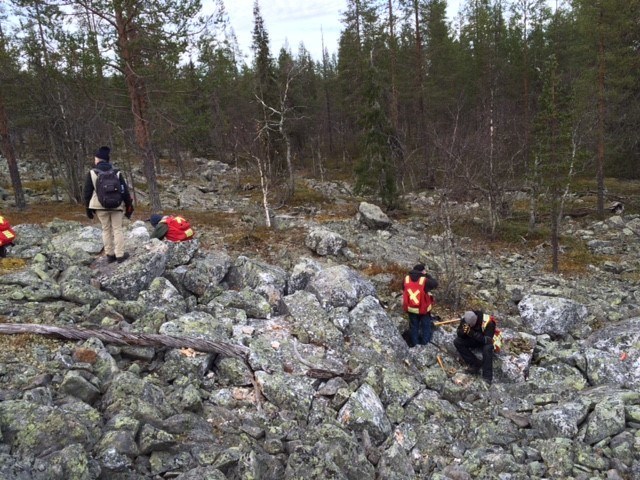
Figure 8: A2 Prospect (new discovery)

